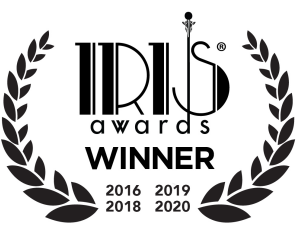Doug Powell designs and dads in chilly Minneapolis, and is the current president of AIGA (American Institute of Graphic Arts, for you non-designers). I had the privilege of hearing Doug speak recently on the topic of AIGA’s Design for Good initiative, as well as his own work inspired by a very personal experience involving his daughter. Doug was kind enough to answer my DDQ&A, as well as some additional questions specific to his presentation on Design for Good.
Q&A with designer dad Doug Powell
Tell me briefly about your design business: how long in business, what kinds of clients you have and/or work you specialize in.
My wife, Lisa, and I founded Schwartz Powell in 1989. For most of that time we operated as a traditional graphic design studio working for a variety of clients ranging from Target and Andersen Windows to local arts organizations and schools. In 2002 our daughter, Maya, was diagnosed with Type 1 diabetes (aka juvenile diabetes) and this caused Lisa and me to really reset our priorities around family and work. One of the outcomes of this experience was a line of products that Lisa and I designed to help families better manage life with diabetes. This grew into a bigger business vision over the subsequent years, applying this approach to a broader range of health care scenarios. In 2007 this business, called HealthSimple, was acquired by a subsidiary of Johnson & Johnson. Since then, I’ve been continuing to work with organizations in the health and nutrition space to work with design and design thinking.
How long have you been a dad? How many kids? Ages?
Our oldest, Zev, is 20 and is a sophomore at Washington University in St. Louis. Our youngest, Maya, is 17 and a senior in high school.
How has fatherhood affected or influenced your work?
Lisa and I have always made an effort to structure our business in a way that it supports our family—rather than the other way around. We love what we do and are dedicated to the highest possible standards professionally and creatively. However, we’re not workaholics (I know, blasphemous for designers), and we made a decision very early in our careers to build our business around our family rather than the other way around.
Have you ever designed anything for or related to your children?
As soon as a designer has children, the kids instantly become their most important clients. Of course we’ve designed birth announcements, bar and bat mitzvah invitations, and countless school auction and band performance posters. This goes with the territory.
Have you done any client work that’s related to children, education, parenting, etc?
In fact, much of our work has had a connection to kids and families. Our work with HealthSimple, for example, was very much about the experience of families living with a chronic health condition. Being parents in that situation ourselves gave us the key insights to create a unique offering for that experience. We’ve also had many clients in education and the arts.
How have your children and/or fatherhood inspired your work?
My daughter is a budding designer and illustrator, as well as a musician and filmmaker. What amazes me about Maya and her peers is how fearless (or perhaps oblivious) they are to the traditional boundaries between creative disciplines. She moves fluidly between writing and recording music, to creating an illustrated ‘zine, to making a video for a class project. She doesn’t have any sense yet (and hopefully this won’t change) that illustrators do “one thing” and designers do “something different.” I admire this and I think there are lessons here for those of us who are further along in our career. Technology and media have blurred the traditional boundaries, which I think is a very good thing.
And conversely, how has being a designer informed or influenced your role as a father?
Naturally we tried to buy only the best-designed baby equipment, toys, books, etc. when our kids were little. But we quickly realized that kids have a very different design sensibility—loud obnoxious noises trump refined colors and cool product design.
Is there any particular child product whose design you really like?
SpongeBob SquarePants is that rare cartoon that is totally mesmerizing for even very young kids, and absolutely hysterical for adults.
Any you can’t stand?
Barney.
A few questions related specifically to his talk on AIGA’s Design for Good campaign:
Can you give a brief history/description of Design for Good?
Through Design for Good, AIGA will activate our 22,000 members to engage in design-driven social change work on a local and global level. Of course, many designers are already working this way, so Design for Good will elevate this existing work by providing tools, resources and experiences to enhance their work. Design for Good really emerged from our membership and chapter leadership—there has been a strong call for AIGA to provide more opportunities for designers to work in this way.
In your talk about Design for Good, you described healthcare as a “design desert,” and that designers have the opportunity to really make a difference, especially in the area of patient experience. Can you give any insight specific to children’s healthcare?
One of the key insights we discovered in our work on HealthSimple is that designing for children is a great way to design for adults. When you are dealing with really complicated and intimidating content (like medical care instructions), it is really important to simplify as much as possible while still conveying the essential information, and to use visuals and bold colors. These are among the principles of designing for children, and they happen to be part of the key to effective design for adults as well. We were very surprised when our original line of diabetes products—designed for children—was so well received by older audiences.
In the conclusion of your presentation, you said, “As we go save the world, don’t forget why we became designers. We have a unique gift. The storytelling aspect will be what makes this distinct.” Storytelling is an especially powerful tool in communicating to children. How do you see child and family-related issues fitting into Design for Good? Are there examples you’ve already seen started, or are in the works/discussion phase?
I see some great early examples of Design for Good projects that relate to kids and families. In the video on the DG site, there are a couple profiles of projects that fit this category: one by Rich Hollant in CT, and another by Jason Stevens in Boston. I think we will see many examples like these emerging from the program over the next year.
How can designers (and non-designers) get involved in Design for Good?
The best way to engage with Design for Good will be through your local AIGA chapter. As the initiative gains momentum, more chapters will be holding participatory workshops for members to work on local issues as part of multi-disciplinary teams. Our goal will be to conduct 4 or 5 of these chapter-level workshops in 2012. You can also submit case studies of existing design-driven social change projects to the DG website on AIGA.org.
For more information on Design for Good: www.aiga.org/design-for-good/
(PS from DD: Between hearing Doug speak, getting to know more about him through this Q&A, and reading up on Design for Good, I’m definitely feeling inspired to live and work a little more outside my comfort zone. It’s so easy to get consumed by my own little world/job/family/home/blog, but I/we really do have a lot to offer. If you’re a designer, writer, photographer, business owner, or just someone looking to give money, I highly encourage you to look into Design for Good!)








